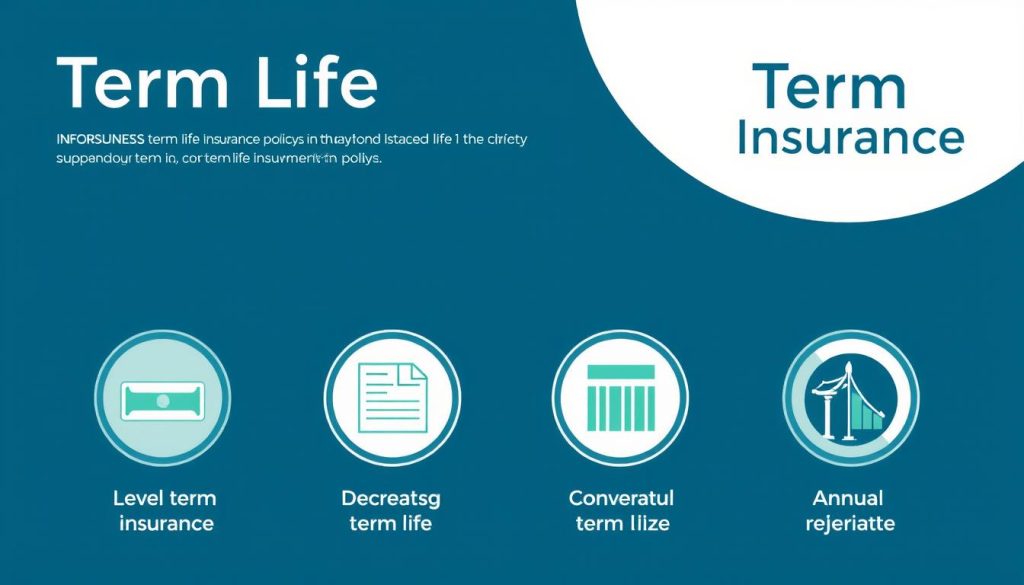Life insurance is a key financial tool that protects your loved ones if you pass away too soon. Term life insurance is a top pick for many families looking for affordable coverage. We’ll explore term life insurance’s benefits, types, and how to find the right coverage for you.
Key Takeaways
- Term life insurance is designed to provide coverage for a specific period of time, typically ranging from 10 to 30 years.
- Premiums for term life insurance are generally much lower than those for whole life insurance, especially for younger individuals.
- The cost of term life insurance is influenced by factors such as your age, health, lifestyle, and occupation.
- Term life insurance policies offer flexible options, including level term, decreasing term, and convertible term.
- Determining the right term life insurance coverage is crucial to ensuring your family’s financial security.
Understanding Term Life Insurance
Term life insurance is a simple and straightforward choice for life insurance. It offers coverage for a set period, known as the “policy term.” This can be anywhere from 10 to 30 years.
You pay a premium, monthly or yearly, to keep the coverage active. Term life insurance premiums are usually lower than permanent life insurance. This is because term policies don’t build up cash value.
What Is Term Life Insurance?
Term life insurance protects your loved ones if you pass away during the policy term. It’s a cost-effective way to ensure your family’s financial security. The coverage ends without a death benefit if you outlive the term.
Term life insurance is flexible. It offers features like early payouts for terminal illnesses or waiving premiums if you become disabled. This adds extra financial security during tough times.
When choosing term life insurance, consider the coverage duration and premium payments. The policy term and coverage amount affect your premiums. Younger, healthier people usually get lower premiums than older ones.
Unlike permanent life insurance, term life insurance doesn’t grow in value over time. However, it’s often more affordable for those needing basic protection for a specific period.
“Term life insurance is the most affordable way to provide your loved ones with valuable financial protection.”
Key Benefits of term life insurance
Term life insurance is a wise choice for protecting your family’s financial future. It offers a tax-free death benefit if you pass away during the policy term. This ensures your loved ones’ financial security.
The death benefit can cover debts, mortgages, or help raise children. It provides the support they need during tough times.
Term life insurance is also affordable. Its premiums are lower than those of permanent life insurance. This makes it easier for many families to get coverage.
It also offers flexible options. You can adjust your coverage as your life and financial needs change.
“Term life insurance is a cost-effective way to provide your loved ones with the financial protection they need. It can give you peace of mind knowing that they will be taken care of if the unthinkable happens.”
Starting a family, buying a home, or planning for the future? Term life insurance is a valuable addition. It ensures your family is protected, even when unexpected things happen.
Types of Term Life Insurance Policies
There are many types of term life insurance to choose from. Each has its own features. Knowing the differences helps you pick the right one for your family.
Level Term Life Insurance
Level term life insurance is the most common. It keeps the death benefit and premiums the same for 10, 15, 20, or 30 years. It’s great for keeping your family’s finances safe.
Decreasing Term Life Insurance
Decreasing term life insurance has a death benefit that goes down over time. But, the premiums stay the same. It’s good for covering debts that go down, like a mortgage.
Convertible Term Life Insurance
Convertible term life insurance lets you switch to permanent life insurance later. You don’t need more medical tests. It’s good when your needs change.
| Policy Type | Death Benefit | Premiums | Flexibility |
|---|---|---|---|
| Level Term Life Insurance | Remains the same | Remains the same | Limited |
| Decreasing Term Life Insurance | Decreases over time | Remains the same | Limited |
| Convertible Term Life Insurance | Remains the same | Remains the same | Flexible (can convert to permanent policy) |
When picking a term life insurance policy, think about your needs now and in the future. Also, consider your budget. The right policy can protect your loved ones well.
Determining Your term life insurance Needs
Figuring out how much term life insurance coverage you need is key to protecting your family’s future. The DIME formula helps by looking at your Debt, Income, Mortgage, and Education costs. It’s also wise to think about your family’s financial needs, like debts and education costs, when picking a policy.
The “10 times income” rule is often mentioned but might not fit everyone’s needs. The DIME formula is more detailed, considering your specific financial duties. It helps figure out the right death benefit for your family.
- Debt: Add up your family’s debts, like your mortgage and credit cards.
- Income: Think about how long your family needs your income to keep their lifestyle, usually 10-15 years.
- Mortgage: Consider the balance left on your mortgage and how many years you have left on the loan.
- Education: Plan for your kids’ future education costs, including tuition and living expenses.
The DIME formula gives a full picture of your family’s needs. Talking about life insurance with your family can also help. It ensures your estimates match their expectations.
Another way to figure out your life insurance needs is to replace your income and add a bit extra. This means dividing your annual income by a safe rate of return, like 4% or 5%. This method helps your family’s financial future.
Choosing the right term life insurance policy is vital for your financial plan. By thinking about your family’s responsibilities and goals, you can protect them from unexpected events.
Conclusion
Term life insurance is a smart, affordable way to protect your loved ones. It offers flexible coverage options that fit modern families’ needs. By understanding its benefits and types, you can ensure your family’s well-being, even when unexpected events occur.
With term life insurance, you can rest easy knowing your family is financially secure. The average annual cost for non-smokers is between $3,187 for women and $4,575 for men. Even smokers can find it affordable, with costs averaging $6,155 for women and $8,773 for men.
Choosing a 10-year, 20-year, or 30-year term life insurance policy lets you customize coverage to your needs and budget. Investing in term life insurance protects your family’s financial future. Don’t wait – explore your options today and secure your loved ones’ financial well-being.
FAQ
What is term life insurance?
How does term life insurance work?
What are the key benefits of term life insurance?
What are the different types of term life insurance policies?
How do I determine my term life insurance needs?
Source Links
- Term Life Insurance Demystified: Why It’s the Smartest Decision for Modern Families
- Term Life Insurance Demystified: Why It’s the Smartest Decision for Modern Families
- Life Insurance: What It Is, How It Works, and How To Buy a Policy
- Term Life Insurance: What It Is, Different Types, Pros and Cons
- Term vs. Whole Life Insurance: What’s the Difference?
- Term life insurance vs. permanent life insurance
- Term Life vs. Whole Life Insurance: Key Differences and How To Choose – NerdWallet
- Term vs. Whole Life Insurance: Key Differences
- Aflac Supplemental Insurance
- Types of Policies
- Different Types of Life Insurance
- What Type of Life Insurance Is Right for You?
- How Much Life Insurance Do I Need? – NerdWallet
- How Much Life Insurance Do I Need?
- Life Insurance Calculator – How much life insurance do I need?
- Term Life Insurance: What It Is and How It Works – NerdWallet
- What happens if you outlive your term life insurance? | Bankrate
- Term Life Vs. Whole Life Insurance Which is Best for You


